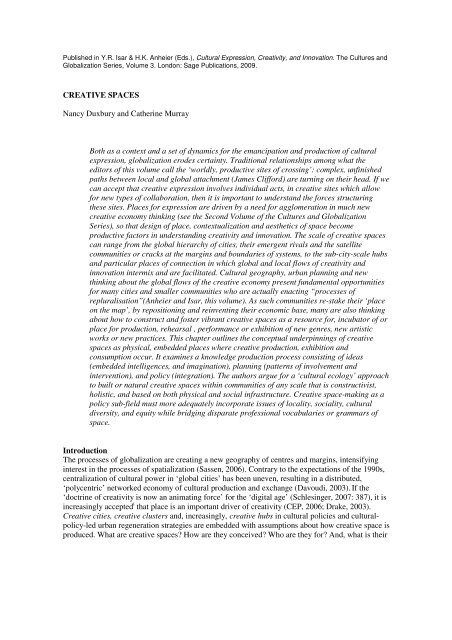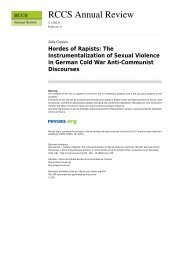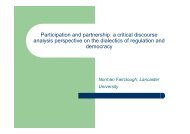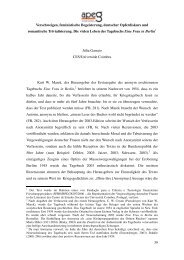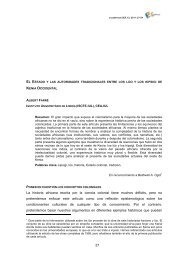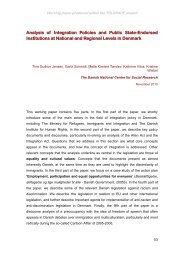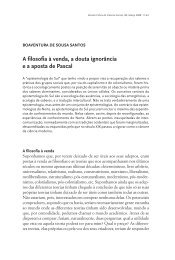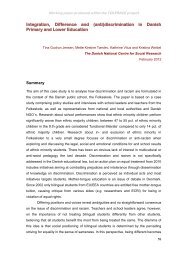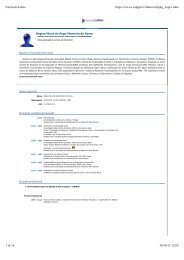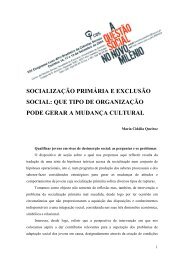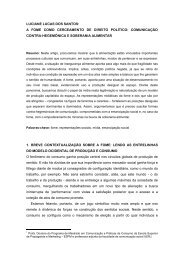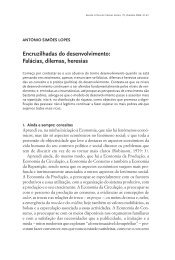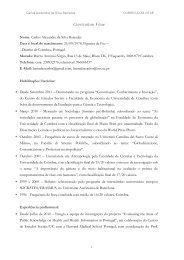CREATIVE SPACES Nancy Duxbury and Catherine Murray Both as ...
CREATIVE SPACES Nancy Duxbury and Catherine Murray Both as ...
CREATIVE SPACES Nancy Duxbury and Catherine Murray Both as ...
Create successful ePaper yourself
Turn your PDF publications into a flip-book with our unique Google optimized e-Paper software.
Published in Y.R. Isar & H.K. Anheier (Eds.), Cultural Expression, Creativity, <strong>and</strong> Innovation. The Cultures <strong>and</strong><br />
Globalization Series, Volume 3. London: Sage Publications, 2009.<br />
<strong>CREATIVE</strong> <strong>SPACES</strong><br />
<strong>Nancy</strong> <strong>Duxbury</strong> <strong>and</strong> <strong>Catherine</strong> <strong>Murray</strong><br />
<strong>Both</strong> <strong>as</strong> a context <strong>and</strong> a set of dynamics for the emancipation <strong>and</strong> production of cultural<br />
expression, globalization erodes certainty. Traditional relationships among what the<br />
editors of this volume call the ‘worldly, productive sites of crossing’: complex, unfinished<br />
paths between local <strong>and</strong> global attachment (James Clifford) are turning on their head. If we<br />
can accept that creative expression involves individual acts, in creative sites which allow<br />
for new types of collaboration, then it is important to underst<strong>and</strong> the forces structuring<br />
these sites. Places for expression are driven by a need for agglomeration in much new<br />
creative economy thinking (see the Second Volume of the Cultures <strong>and</strong> Globalization<br />
Series), so that design of place, contextualization <strong>and</strong> aesthetics of space become<br />
productive factors in underst<strong>and</strong>ing creativity <strong>and</strong> innovation. The scale of creative spaces<br />
can range from the global hierarchy of cities, their emergent rivals <strong>and</strong> the satellite<br />
communities or cracks at the margins <strong>and</strong> boundaries of systems, to the sub-city-scale hubs<br />
<strong>and</strong> particular places of connection in which global <strong>and</strong> local flows of creativity <strong>and</strong><br />
innovation intermix <strong>and</strong> are facilitated. Cultural geography, urban planning <strong>and</strong> new<br />
thinking about the global flows of the creative economy present fundamental opportunities<br />
for many cities <strong>and</strong> smaller communities who are actually enacting “processes of<br />
repluralisation”(Anheier <strong>and</strong> Isar, this volume). As such communities re-stake their ‘place<br />
on the map’, by repositioning <strong>and</strong> reinventing their economic b<strong>as</strong>e, many are also thinking<br />
about how to construct <strong>and</strong> foster vibrant creative spaces <strong>as</strong> a resource for, incubator of or<br />
place for production, rehearsal , performance or exhibition of new genres, new artistic<br />
works or new practices. This chapter outlines the conceptual underpinnings of creative<br />
spaces <strong>as</strong> physical, embedded places where creative production, exhibition <strong>and</strong><br />
consumption occur. It examines a knowledge production process consisting of ide<strong>as</strong><br />
(embedded intelligences, <strong>and</strong> imagination), planning (patterns of involvement <strong>and</strong><br />
intervention), <strong>and</strong> policy (integration). The authors argue for a ‘cultural ecology’ approach<br />
to built or natural creative spaces within communities of any scale that is constructivist,<br />
holistic, <strong>and</strong> b<strong>as</strong>ed on both physical <strong>and</strong> social infr<strong>as</strong>tructure. Creative space-making <strong>as</strong> a<br />
policy sub-field must more adequately incorporate issues of locality, sociality, cultural<br />
diversity, <strong>and</strong> equity while bridging disparate professional vocabularies or grammars of<br />
space.<br />
Introduction<br />
The processes of globalization are creating a new geography of centres <strong>and</strong> margins, intensifying<br />
interest in the processes of spatialization (S<strong>as</strong>sen, 2006). Contrary to the expectations of the 1990s,<br />
centralization of cultural power in ‘global cities’ h<strong>as</strong> been uneven, resulting in a distributed,<br />
‘polycentric’ networked economy of cultural production <strong>and</strong> exchange (Davoudi, 2003). If the<br />
‘doctrine of creativity is now an animating force’ for the ‘digital age’ (Schlesinger, 2007: 387), it is<br />
incre<strong>as</strong>ingly accepted i that place is an important driver of creativity (CEP, 2006; Drake, 2003).<br />
Creative cities, creative clusters <strong>and</strong>, incre<strong>as</strong>ingly, creative hubs in cultural policies <strong>and</strong> culturalpolicy-led<br />
urban regeneration strategies are embedded with <strong>as</strong>sumptions about how creative space is<br />
produced. What are creative spaces? How are they conceived? Who are they for? And, what is their
“Cultural Spaces” (<strong>Duxbury</strong> & <strong>Murray</strong>) Ple<strong>as</strong>e do not circulate<br />
relationship to fostering <strong>and</strong> harnessing the force of creative expression for cultural, social, <strong>and</strong><br />
economic advancement?<br />
Creative spaces are often considered a synonym for cultural facilities, cultural/creative milieus,<br />
enclaves, corridors, quarters, districts, clusters, or creative hubs. They are defined <strong>as</strong> places where<br />
creative production <strong>and</strong> performance occur by chance or design. They are place-b<strong>as</strong>ed <strong>and</strong> place<br />
contingent. While creative space may be virtual, the focus here is on the physical, material<br />
representation of space or how it is conceived. In this way, we are building upon Henri Lefebrve’s<br />
(1991) notion of space <strong>as</strong> a product of the processes <strong>and</strong> work of creativity performed <strong>and</strong><br />
experienced by humans. ii Creative spaces in this lexicon are what may be called ‘creative hardware’<br />
(Richards <strong>and</strong> Wilson, 2007). They are more than just l<strong>and</strong>, buildings, parks, precincts or districts –<br />
they are socially constructed products of physical facility/place, people, <strong>and</strong><br />
programming/operational resources. They carry significant iconic or symbolic value. Creative<br />
spaces operate between current reality <strong>and</strong> possibility.<br />
The focus of this chapter is on the creative coming together of different groups, l<strong>and</strong> uses,<br />
residential forms, <strong>and</strong> architectural styles to make creative spaces in an urban environment. Creative<br />
space-making is a practice rooted in three dynamic, interrelated domains: ide<strong>as</strong>, planning <strong>and</strong><br />
policy, <strong>and</strong> on-the-ground entrepreneurialism. As new configurations <strong>and</strong> practices of creative<br />
space development emerge, various degrees of ‘misalignment’, friction, <strong>and</strong> disconnectedness<br />
among these three domains become evident.<br />
Conceptual Background<br />
Thinking about creative space is strongly influenced by the disciplines of cultural geography,<br />
architecture, industrial design, <strong>and</strong> urban/community planning. iii Creative space-making is an<br />
emergent policy sub-field, incre<strong>as</strong>ingly differentiated from, but indebted to, thinking about creative<br />
cities, creative industries, economy <strong>and</strong> society. The goal of creative space-making is to identify<br />
<strong>and</strong> optimize strategies for building, adapting, or renovating the necessary infr<strong>as</strong>tructure <strong>and</strong><br />
environment in which human creativity can flourish. A number of cultural policy paradigms guide<br />
creative space-making. The neo-liberal paradigm of the creative economy iv led to urban<br />
entrepreneurialism <strong>as</strong> the competitive response of cities <strong>and</strong> a new hierarchy of global cities<br />
(S<strong>as</strong>sen, 2006). Creative spaces are treated <strong>as</strong> sites for spectacle <strong>and</strong> consumption (Hannigan,<br />
2007). Cities <strong>and</strong> nation states designed ‘flagship’ spatial amenities to provide magnets for foreign<br />
capital, attract the creative migrant cl<strong>as</strong>s, <strong>and</strong> exp<strong>and</strong> cultural tourism during the fiscal crisis<br />
triggered by footloose manufacturing plants <strong>and</strong> loss of jobs offshore. But such instrumentalizing of<br />
creative space <strong>as</strong> an ‘amenity’ in tourism-led growth strategies failed to explore the relationship of<br />
creative spaces to endogenous creative processes. Hence, influenced by high-tech districts <strong>and</strong> their<br />
economic spin-offs, cultural centres or clusters began to be conceived of <strong>as</strong> cultural-economic hubs<br />
<strong>and</strong> generators of growth, with locality conceived of <strong>as</strong> a resource or visual stimuli, an energizing<br />
‘buzz’ <strong>and</strong> br<strong>and</strong> b<strong>as</strong>ed on tradition <strong>and</strong> reputation (Drake, 2003).<br />
The Blair New Labour turn to the ‘creative city’ strategy of urban regeneration broadened the<br />
traditional aesthetic focus on cultural policy to other ‘creative’ sectors such <strong>as</strong> design <strong>and</strong> f<strong>as</strong>hion<br />
<strong>and</strong> examining creativity <strong>as</strong> an input into other are<strong>as</strong> of the networked economy (Throsby, 2001;<br />
Flew, 2002; Hartley, 2007). Location <strong>and</strong> place remain central to this largely UK-led creative<br />
city/economy policy paradigm, but the target for such facilities switched from the tourist to the<br />
attraction of highly skilled new residents or local creative workers. Built-out spaces featured arts<br />
<strong>and</strong> entertainment districts, anchors in streetscape renewal projects, the promotion of nighttime<br />
economies, pedestrian plaz<strong>as</strong>, <strong>and</strong> new collaboration between private developers/investors <strong>and</strong> not-<br />
2
“Cultural Spaces” (<strong>Duxbury</strong> & <strong>Murray</strong>) Ple<strong>as</strong>e do not circulate<br />
for-profit creative groups (Gibson <strong>and</strong> Holman, 2004). Evans (2007) calls this a shift from a<br />
singular cultural br<strong>and</strong>ing approach to city spaces that depend on creative diversity <strong>and</strong> tension<br />
rather than predictability, or ‘riskless risk’. In this view, cosmopolitan or creative cities offer a more<br />
sustainable spatial distribution <strong>and</strong> diversity of cultural <strong>and</strong> visitor activity.<br />
From a survey of literature from over 38 countries with some evidence of ‘creative economy/cluster<br />
or city’ approaches (Gollmitzer <strong>and</strong> <strong>Murray</strong>, 2008), we can accept that strategic creative space<br />
planning is incre<strong>as</strong>ingly part of urban planning, with a spatial dimension that is city-wide, <strong>and</strong><br />
works to establish cultural facility priorities. In parallel with these developments, a focus on the<br />
changing sociology of the global city led by Sharon Zukin, Peter Hall, S<strong>as</strong>kia S<strong>as</strong>sen <strong>and</strong> others,<br />
began to ripple through urban studies, building on the earlier community development paradigms of<br />
the early 1960s, which focused on urban poverty, social welfare maximization <strong>and</strong> urban<br />
regeneration projects. This ‘progressive’ tradition in urban planning persists today, <strong>and</strong> now<br />
struggles to articulate culture with sustainability <strong>and</strong> distributive equity <strong>as</strong> a planning goal. v The<br />
challenge is to frame cultural strategies for creative spaces in urban revitalization that address social<br />
<strong>and</strong> environmental goals without ignoring economic realities.<br />
A Creative Ecology Approach<br />
There are typically three bi<strong>as</strong>es to policy ide<strong>as</strong> about creative space-making. First, the creative<br />
clusters or hubs are primarily portrayed through an economic or political economic lens, with only<br />
limited acknowledgement of ties to the broader socio-cultural communities in which they reside.<br />
Second, creative clusters are often described <strong>as</strong> a bundle of dynamics <strong>and</strong> activities without a sense<br />
of how space(s) may be supporting, enabling, or enhancing the various stages of creative processes.<br />
In a sense, creativity is valorized but still plays out in a black box which hides how the various<br />
creative stages may be appropriately ‘housed.’ Third, the bulk of the literature generally focuses on<br />
‘global’ cities exclusively, although this thinking is incre<strong>as</strong>ingly taken up in theories about<br />
‘polycentricity’ (Davoudi, 2003), ‘ordinary cities’ (Robinson, 2006), <strong>and</strong> small cities <strong>and</strong><br />
communities (e.g., Garrett-Petts, 2005) <strong>as</strong> well.<br />
As a corrective to these bi<strong>as</strong>es, a more holistic model of developing creative spaces for cultural<br />
development, experimentation, <strong>and</strong> evolution is emerging. The social <strong>and</strong> cultural-creative<br />
processes of use that inhabit <strong>and</strong> give life to these spaces are of first concern, acknowledging ‘the<br />
simultaneous co-existence of social interrelationships at all geographical scales’ (M<strong>as</strong>sey, 1994),<br />
from the intimacy of the home, local pub, or community cultural centre, to the wide spaces of transglobal<br />
connections.<br />
From a planning perspective, Charles L<strong>and</strong>ry’s Cycle of Urban Creativity w<strong>as</strong> one of the first<br />
models to outline a systematic holistic approach to creativity within an urban context (L<strong>and</strong>ry,<br />
2000). vi More recently, wide-spread community sustainability initiatives have also encouraged a<br />
holistic, systems-b<strong>as</strong>ed planning approach, frequently including cultural, economic, environmental,<br />
<strong>and</strong> social dimensions of sustainable development (e.g., Hawkes, 2001; City of Port Phillip, 2002;<br />
New Zeal<strong>and</strong> Ministry for Culture <strong>and</strong> Heritage, 2006; Regional Vancouver Urban Observatory,<br />
2006; Infr<strong>as</strong>tructure Canada, 2008). Creative space-making includes more voluntary b<strong>as</strong>is for<br />
actions (compared to a heavily legislated, top-down approach) <strong>and</strong> is rooted in local decisionmaking,<br />
participatory planning <strong>and</strong> priority-setting, integrated planning, <strong>and</strong> (ideally) horizontal<br />
coordination across municipalities <strong>and</strong> other local agencies within regions (e.g., districts, counties,<br />
etc.) (<strong>Duxbury</strong> et al., 2008). While useful, L<strong>and</strong>ry’s model does not open the black box of the<br />
cognitive repertoire for creative space-making. To do this, we must turn to a framework for<br />
knowledge production, borrowed here from Yoshiteru Nakamori, which examines the dynamics of<br />
3
“Cultural Spaces” (<strong>Duxbury</strong> & <strong>Murray</strong>) Ple<strong>as</strong>e do not circulate<br />
intelligence, imagination, involvement, intervention <strong>and</strong> integration in creative space making in<br />
cities (Wierzbicki <strong>and</strong> Nakamori, 2005).<br />
Towards a More Holistic Model of Creative Processes in Creative Spaces<br />
Peter Hall, among others, h<strong>as</strong> lamented the division of professional intelligences about the place of<br />
culture in urban space in geography, sociology, economics, architecture, cultural studies, or urban<br />
studies (Hall <strong>and</strong> Pain, 2006). Too few have taken up the call for a new ‘urban literacy’ that would<br />
more broadly disperse <strong>and</strong> interconnect this knowledge b<strong>as</strong>e <strong>and</strong> the skills to ‘read’ a city’s ‘look<br />
<strong>and</strong> feel’ of its creative spaces (Centre for Public Space Research, 2004). Creative attributes of<br />
space, place, <strong>and</strong> form (or semiotics of structures <strong>and</strong> other built ‘objects’) need to be more debated<br />
<strong>and</strong> diffused among the respective design <strong>and</strong> urban planning communities (Hutton, 2006).<br />
Intelligence<br />
Spatial vocabularies of power have long been embedded in conceptions of urban-rural, centreperiphery,<br />
<strong>and</strong> downtown slums-affluent residential are<strong>as</strong> (Lee, 2007). At issue is how spaces for<br />
cultural/creative rehearsal, production, performance <strong>and</strong> archiving are included. The traditional<br />
ensembles of urban space <strong>and</strong> form like the piazza, village square, or public commons have been<br />
anchored by a cultural performance space (typically a theatre or museum). Intelligence about<br />
creative space, usually organized by the predominant aesthetic or professional/artistic disciplines,<br />
h<strong>as</strong> traditionally involved large-scale, purpose-built spaces. As more participatory cultural policy<br />
approaches developed, spaces became multifunctional, scaled down, or more flexible in use <strong>and</strong><br />
(depending on urban regime) clustered around public transit nodes or other green space to<br />
encourage daily presence. Indeed, variable scale to creative space becomes crucially important in<br />
adapting to change over time.<br />
Of particular interest in cultural studies are the cognitive repertoires of visual cityscapes in<br />
modernist <strong>and</strong> post modernist sensibilities. vii Building design in the old industrial economy for<br />
cultural institutions w<strong>as</strong> largely about maintaining control, where<strong>as</strong> the social order <strong>and</strong> design<br />
values of the new economy stress freedom in the selective are<strong>as</strong> of labour <strong>and</strong> identity. In spatial<br />
politics, the two most critical dimensions are: (1) to balance the need to be central or to position at<br />
the margins of the city, consciously maintaining an alternative, bohemian atmosphere (see, e.g.,<br />
Mercer, 2006); <strong>and</strong> (2) to establish an identifiable st<strong>and</strong>ing place with strongly shared<br />
representations <strong>and</strong>/or an open <strong>and</strong> flexible space constantly adapting to changes in the wider<br />
cultural <strong>and</strong> urban field (Momma<strong>as</strong>, 2004). Diversity is widely accepted <strong>as</strong> a dominant design ethic:<br />
in addition to ‘function mixing’—old, new, closed, open <strong>and</strong> so on—there is attention to day/night<br />
economies, <strong>and</strong> chances for accidental encounters to frame intercultural curiosity or a cosmopolitan<br />
imagination (Hospers, 2003). However, the growing anxiety about public security after 9/11 shows<br />
incre<strong>as</strong>ing preoccupation with the spatial policing of heterogeneity (Cochrane, 2007), surveillance,<br />
<strong>and</strong> social control. Yet creativity thrives in the tension between orderly <strong>and</strong> disorderly space, so<br />
managing the interplay of these zones is crucial.<br />
New taxonomies of creative spaces are emerging. They can be <strong>as</strong>sembled on the b<strong>as</strong>is of their role<br />
in the cultural-creative value chain (experimentation, creation, rehearsal, performance, exhibition,<br />
archiving); their role in creative knowledge production (from visible knowledge to invisible or tacit<br />
knowledge); cognitive-experiential modes of cultural participation; or fixity or flow in the<br />
knowledge economy (Markus, 1993; Bennett et al., 1999; C<strong>as</strong>tells, 1996). In response to Richard<br />
Florida’s (2002) creative cl<strong>as</strong>s thesis, more attention is being placed on attributes of emotional<br />
affect. Spatial cognition looks at the means by which people construct an image of the city in which<br />
4
“Cultural Spaces” (<strong>Duxbury</strong> & <strong>Murray</strong>) Ple<strong>as</strong>e do not circulate<br />
they live, <strong>and</strong> translate this into awareness <strong>and</strong> identification (Hospers, 2003). With the focus on the<br />
role of cultural amenities on attracting creative workers viii new studies identify the appealing<br />
aesthetic attributes which provoke ‘aesthetic curiosity’ (the unexpected use of the alley, the<br />
compatibility with night life), ‘place’ (the attachment of boundedness, coziness, <strong>and</strong> authenticity),<br />
sociality (opportunities for informal co-location or clustering of different creative disciplines), <strong>and</strong><br />
diversity (historic building <strong>and</strong> other amenity types ix ) (Helbrecht, 2003; Hutton, 2006).<br />
Imagination<br />
The <strong>as</strong>pirational <strong>as</strong>pect of the creative space imaginary is a remarkable resource—looking outward,<br />
globally <strong>and</strong> competitively, <strong>and</strong> inward, locally <strong>and</strong> co-operatively. Critiques of disembedded<br />
visions of ‘starchitects’ in the period of spectacle <strong>and</strong> consumption are now so well known they<br />
have generated vernacular shorth<strong>and</strong>: the Bilbao effect. x Opposing this view, in the organic ecology<br />
paradigm (influenced by urban theorist Jane Jacobs) is the postulate that the roots of creative spaces<br />
always lie in the existing, historically developed urban environment (Hospers, 2003). The best<br />
strategy is always to <strong>as</strong>sess the actual situation <strong>and</strong> needs for creative space-making, renovating or<br />
adapting in particular contexts. xi In these ways, imagination connects space to place. Places are<br />
spaces with meaning <strong>and</strong> local knowledge attached. Spatial imaginaries are most productive when<br />
local <strong>and</strong> grounded.<br />
From our meta-analysis of extensive literatures on cultural infr<strong>as</strong>tructure <strong>and</strong> creative space, the<br />
leading trends in re-conceptualizing creative space goals include recovering rurality <strong>as</strong> lived<br />
creative space (Cloke, 2007) or the ‘slow’ urban movement, identifying how to construct<br />
‘empathetic destinations’ to avoid the exploitative tourist frame on cultural development (Richards<br />
<strong>and</strong> Wilson, 2007), <strong>and</strong> how to define ‘authenticity’ (i.e., unique, local differentiation) in creative<br />
city visions.<br />
Current trends in physical creative space developments reflect changing artistic practices, a new<br />
design ethic of intermixture <strong>and</strong> involvement, <strong>and</strong> ‘flexibilization’ of space. xii The models presented<br />
here <strong>as</strong> incubators, creative habitats, multi-sector convergence projects are not mutually exclusive.<br />
Indeed, combinations of operating models are emerging that blur the lines between for-profit <strong>and</strong><br />
not-for-profit creative enterprises, influencing how cultural-creative activity is organized, how<br />
spaces are used <strong>and</strong> governed, <strong>and</strong> challenging the funding systems <strong>and</strong> planning contexts.<br />
Incubators<br />
Cultural or creative incubators form an ‘umbrella type’ of creative spaces that offer various<br />
platforms of support for creators <strong>and</strong> enable connection, production, <strong>and</strong> networking among creators<br />
<strong>and</strong> their publics. Artist co-operatives, media arts centres, <strong>and</strong> new media artist-run centres, <strong>as</strong><br />
examples, benefit from coming together to share specialized equipment <strong>and</strong> production spaces.<br />
While some incubators are multidisciplinary in nature, many others are defined by their specialties<br />
(e.g., f<strong>as</strong>hion, visual arts, film), usually serving a ‘hub’ role for particular communities, operating <strong>as</strong><br />
extensions of them, <strong>and</strong> evolving over time. They may be municipality-owned-<strong>and</strong>-operated, notfor-profit<br />
co-operatives <strong>and</strong> societies, or a combination of commercial <strong>and</strong> not-for-profit<br />
organizations.<br />
5
“Cultural Spaces” (<strong>Duxbury</strong> & <strong>Murray</strong>) Ple<strong>as</strong>e do not circulate<br />
Méduse Coopérative, Quebec City, Canada<br />
Méduse comprises 10 independent studios (woodworking, stone, metal, engraving, <strong>and</strong><br />
multipurpose), <strong>and</strong> range of services including a photography lab, exhibition rooms, <strong>and</strong> rehearsal,<br />
photography, sound, film, video, <strong>and</strong> radio studios. It contains space for archiving <strong>and</strong> equipment<br />
storage, offices, a central computer server, café-bistro, <strong>and</strong> an artist studio-apartment (for<br />
international residencies). Approximately 60 per cent of the space is dedicated to development <strong>and</strong><br />
40 per cent to exhibition.<br />
http://www.meduse.org/<br />
Arts House, Melbourne, Australia<br />
Arts House, operating from a collection of historic public buildings, is an arts centre operated by the<br />
City of Melbourne. It integrates subsidized office/work space for arts organizations <strong>and</strong> individual<br />
artists, performance spaces, rehearsal <strong>and</strong> development spaces, meeting rooms, galleries, a digital<br />
media <strong>and</strong> sound studio (with recording capability), visual arts studios, a writers’ lab, <strong>and</strong> a<br />
producers’ hub. Arts House provides support for artists from exploration/creation through to<br />
presentation/exhibition, promotion, <strong>and</strong> touring, <strong>and</strong> h<strong>as</strong> built a reputation for working<br />
interculturally (Beal, 2008).<br />
http://www.melbourne.vic.gov.au/info.cfm?top=186&pg=2163<br />
Creative habitats<br />
Evolving from incubators <strong>as</strong> singular buildings, discourse is exp<strong>and</strong>ing to a broader perspective of<br />
creative habitats <strong>as</strong>king, from the perspective of a creative production ecology, what do artists need<br />
to thrive? Jones (2008) identified key components of a creative production milieu <strong>as</strong>: space <strong>and</strong><br />
place (mixed living/working spaces), networks <strong>and</strong> a sense of community, entrepreneurial support,<br />
<strong>and</strong> neighbourhoods with distinctive <strong>and</strong> authentic features. Other desirable features include<br />
alternative, experimental spaces allowing for ‘fluid streams’ of activity; use of ‘non-traditional’<br />
public domain spaces by artists for temporary projects; locally grounded ‘creative spaces enabling<br />
networks’; <strong>and</strong> artists treated <strong>as</strong> creative resources for a broader community. xiii<br />
Multi-sector convergence projects<br />
Crucial to a creative economy, convergence centres are vibrant physical places designed to<br />
maximize socialization, networking, <strong>and</strong> r<strong>and</strong>om collisions within them. Cross-sectoral<br />
convergence centres are leading to new sustainable operating models of shared sites <strong>and</strong> spaces.<br />
Notably, these projects are often situated within re-purposed heritage buildings—another recurring<br />
theme is the restoration or rehabilitation of spaces for repurposed uses. Some projects are designed<br />
<strong>as</strong> ‘public realm’ while others are more inwardly focused.<br />
The Artscape Wychwood Barns, Toronto, Canada<br />
Toronto Artscape, the City of Toronto, <strong>and</strong> the Stop Community Food Centre are transforming<br />
historic streetcar repair barns into a multifaceted art centre, community centre, <strong>and</strong> environment<br />
centre. It will include artist live-work <strong>and</strong> studio tenancies <strong>and</strong> features such <strong>as</strong> a commercial<br />
kitchen, community wood-burning bake oven, communal gardens, <strong>and</strong> camps for children. The<br />
diversity of the components is facilitating interesting cross-linkages.<br />
http://www.torontoartscape.on.ca/barns/<br />
6
“Cultural Spaces” (<strong>Duxbury</strong> & <strong>Murray</strong>) Ple<strong>as</strong>e do not circulate<br />
Waag Society, Amsterdam, The Netherl<strong>and</strong>s<br />
The Waag Society w<strong>as</strong> founded to make new media available to those with minimal access to<br />
computers <strong>and</strong> Internet. The medialab developed into an ‘avant-gardistic thinktank’, building<br />
technology around social <strong>and</strong> cultural issues, <strong>and</strong> is active in the fields of networked art, healthcare,<br />
education, <strong>and</strong> Internet-related issues. It operates from its own heritage Waag Building <strong>and</strong> Pakhuis<br />
de Zwijger, a renovated warehouse that also houses the Media Guild. Partners come from all sectors<br />
of society.<br />
http://www.waag.org/<br />
Involvement<br />
In an era when historical recollection of built form <strong>and</strong> its social context is thin, how do artists,<br />
planners, <strong>and</strong> citizens seek to balance the aims of economic efficiency, social welfare, <strong>and</strong><br />
environmental sustainability with beauty <strong>and</strong> liveability? As Uzzell et al. (2002) note, the value<br />
framework interrelating the environment <strong>and</strong> cultural/social/urban development must take into<br />
account both the objective environment (physical environment, natural resources) <strong>and</strong> the<br />
psychological <strong>and</strong> phenomenological environment (perception <strong>and</strong> evaluation of cultural resources,<br />
group reference, expectancies, lifestyles). Design can be ‘an active force in the sustainability of<br />
culture by reflecting <strong>and</strong> representing the respective people <strong>and</strong> places in which it is working’<br />
(Blankenship, 2005: 24). xiv<br />
Participatory planning exercises bring collective visioning to communities, developing new<br />
techniques to bridge specialized discourses to everyday vocabularies <strong>and</strong>, incre<strong>as</strong>ingly, using<br />
expressive tools <strong>and</strong> social networking sites for citizens to ‘map’ their local cultural iconic spaces.<br />
These exercises may also include consultations with artistic groups to identify unmet space needs.<br />
Channelling this information through local planning regimes with separate recreational,<br />
engineering, social, cultural, <strong>and</strong> l<strong>and</strong> use bureaucracies imposes complex challenges in reconciling<br />
professional languages <strong>and</strong> worldviews to influence local politicians.<br />
At the same time, a new entrepreneurialism is taking root, xv <strong>and</strong> online resource hubs in numerous<br />
cities (e.g., CAR in Chicago) are helping to build independent entrepreneurial capacity to envision<br />
<strong>and</strong> plan, conduct fe<strong>as</strong>ibility analyses, <strong>and</strong> fundraise for their spatial ventures. Yet sustaining longterm<br />
community involvement of volunteers in public initiatives is challenging (Cochrane, 2007). A<br />
multi-generational strategy is needed to maintain the involvement of a largely volunteer or<br />
‘precarious’ b<strong>as</strong>e of creative labour in governance of creative space-making.<br />
Intervention<br />
Cities are implicated in complex systems of governance, with sharply different constitutional<br />
powers <strong>and</strong> fiscal levers. Not only is there a trend to multilevel governance, incre<strong>as</strong>ingly, armslength<br />
creative development agencies (such <strong>as</strong> Creative Scotl<strong>and</strong>) interact with multiple tiers of city,<br />
regional, state, national, <strong>and</strong> private-sector interests, <strong>and</strong> there is an incre<strong>as</strong>ed corporatization of<br />
form (e.g., arrangements including private sector developers, not-for-profit entrepreneurs, etc.).<br />
In cities where the rise to develop ‘creative spaces’ h<strong>as</strong> been taken up most keenly, the desire for<br />
‘enabling’ structures, organizational cultures, <strong>and</strong> milieu to encourage creative activity have often<br />
initially spawned top-down policy–management structures (Schlesinger, 2007). <strong>Both</strong> in practice <strong>and</strong><br />
in the literature, a collective call for replacing this ‘meta-structure’ mentality with more organic,<br />
gr<strong>as</strong>sroots-directed, flexible <strong>and</strong> enabling conditions/support is emerging (e.g., S<strong>and</strong>ercock, 2003;<br />
Crossick, 2006; Goldbard, 2006; Schlesinger, 2007; Stern <strong>and</strong> Seifert, 2007, among others).<br />
7
“Cultural Spaces” (<strong>Duxbury</strong> & <strong>Murray</strong>) Ple<strong>as</strong>e do not circulate<br />
The most important variables in the construction of creative spaces are city l<strong>and</strong> ownership <strong>and</strong><br />
control over use of l<strong>and</strong>, property, <strong>and</strong> premises. In 2002, London <strong>and</strong> Toronto identified a range of<br />
levers for municipal intervention in creative spaces including: creative cluster strategies, designing<br />
creative quarters, liberalizing zoning regulations, promoting positive images of diversity, <strong>and</strong> direct<br />
<strong>and</strong> indirect support for creative enterprises (Evans et al., 2006). Direct ownership <strong>and</strong> operation of<br />
facilities is the most <strong>as</strong>sertive way to build creative space, <strong>as</strong> is building public artist housing (or<br />
work-live space). Use of public-private partnerships <strong>and</strong> business improvement districts is also<br />
incre<strong>as</strong>ing.<br />
Individual cities, regional <strong>and</strong> national programs, <strong>and</strong> supra-national programs (such <strong>as</strong> the EU<br />
Cultural Capitals program) have provided money to enable development of cultural facilities across<br />
many cities <strong>and</strong> communities of different scales. In the spread of creativity <strong>as</strong> a mode of policy<br />
address around the world, China (Keane, 2007), Singapore, South Korea <strong>and</strong> the United Arab<br />
Emirates have made dramatic infusions of public investment in flagship cultural facilities. However,<br />
while knowledge <strong>and</strong> cultural perspectives on creative space-making circulate in global policy<br />
networks, there are few systematic comparisons of cultural infr<strong>as</strong>tructural investments <strong>and</strong> it is<br />
difficult to compile public accounts of cultural <strong>as</strong>sets (Waltman D<strong>as</strong>chko, 2008).<br />
Private or civil society-sector investment in creative spaces is a growing part of the picture. Finance<br />
models for creative spaces are typically dependent upon a variety of mechanisms <strong>and</strong> sources, many<br />
enabled by legislation specific to a country or sub-national region. Challenges are emerging with<br />
traditional sector-specific funding frameworks that cannot embrace blended for-profit <strong>and</strong> non-forprofit<br />
interconnections, <strong>and</strong> a reformed private-public financial framework is needed. In the<br />
discourse around creative space development <strong>and</strong> operation, three overarching financial models are<br />
emerging: non-profit real estate development, non-profit <strong>and</strong> community investment funds, <strong>and</strong><br />
social enterprise development (<strong>Duxbury</strong> et al., 2008).<br />
Integration<br />
Issues of sustainability overarch all development initiatives today. Sustainability is fundamentally<br />
about adapting to a new ethic of living on the planet <strong>and</strong> creating a more equitable <strong>and</strong> just society<br />
through the fair distribution of social goods <strong>and</strong> resources in the world (Darlow, 1996). The most<br />
common definition of sustainable development comes from the World Commission on Environment<br />
<strong>and</strong> Development 1987 report, Our Common Future: ‘Sustainable development is development that<br />
meets the needs of the present without compromising future generations to meet their own needs’<br />
(p. 43). Traditionally, sustainability h<strong>as</strong> been focused on an environmentalism framework, <strong>and</strong><br />
environmental concerns continue to be the cornerstone of sustainable development. As the concept<br />
h<strong>as</strong> matured, however, incre<strong>as</strong>ing emph<strong>as</strong>is h<strong>as</strong> been placed on its interconnection to social <strong>and</strong><br />
economic dimensions of development, <strong>and</strong> space h<strong>as</strong> opened up for debate <strong>and</strong> further reflection<br />
(Kadekodi, 1992; Nurse, 2006a). Culture is gradually becoming a part of this vision <strong>and</strong> discourse.<br />
Culture <strong>as</strong> a key dimension of sustainability is a thinly distributed but perv<strong>as</strong>ive idea in the<br />
community development <strong>and</strong> sustainability literature (<strong>Duxbury</strong> <strong>and</strong> Gillette, 2007), traditionally<br />
discussed in terms of cultural capital <strong>and</strong> defined <strong>as</strong> ‘traditions <strong>and</strong> values, heritage <strong>and</strong> place, the<br />
arts, diversity <strong>and</strong> social history’ (Rosel<strong>and</strong> et al., 2005: 12). The emerging framework incorporates<br />
more dynamic <strong>and</strong> expansive perspectives in which culture is more broadly conceived <strong>as</strong> ‘a whole<br />
way of life’ informing ‘underlying belief systems, worldviews, epistemologies <strong>and</strong> cosmologies’<br />
(Nurse, 2006a: 36). xvi Current literature on culture <strong>and</strong> sustainability incorporates cross-cutting<br />
concerns about cultural vitality, cultural continuity xvii , social embeddedness, social equity, <strong>and</strong> deep<br />
8
“Cultural Spaces” (<strong>Duxbury</strong> & <strong>Murray</strong>) Ple<strong>as</strong>e do not circulate<br />
environmental knowledge (see, e.g., Ch<strong>and</strong>ler <strong>and</strong> Lalonde, 1998; Uzzell et al., 2002; Doubleday et<br />
al., 2004; Blankenship, 2005; Nurse, 2006a, 2006b; Rhoades, 2006; Thorpe, 2007).<br />
The conceptual idea behind this fourfold model is deceptively simple: creative expression <strong>and</strong><br />
participation, which is at the heart of the dynamism of human settlements, requires unlocking the<br />
energies of the social economy of artists, citizens, volunteers <strong>and</strong> not-for-profit groups to work <strong>and</strong><br />
play in around <strong>and</strong> through the formal creative economy. This social economy in turn adds value<br />
which produces economic growth <strong>and</strong> prosperity horizontally across many economic sectors within<br />
the carrying capacity of the natural environment. This ecological value chain in turn is embedded in<br />
a supportive culture which celebrates a sustainable ethos, <strong>and</strong> produces the symbolic capital to<br />
sustain it. Specific planning <strong>and</strong> policy initiatives (e.g., requiring a cultural <strong>as</strong>sessment in reviewing<br />
development initiatives <strong>and</strong> plans, enforcing LEED st<strong>and</strong>ards on cultural facilities, commissioning<br />
public art for important social <strong>and</strong> heritage sites, integrating cultural spaces with affordable housing<br />
or social programs for at risk groups, valuing the role of volunteer contributions in calculations of<br />
economic contributions, or taxing tourism businesses for carbon offsets or reinvestment in arts<br />
activities) are all ways to ensure the four pillars are considered equally <strong>and</strong> integrated with each<br />
other <strong>and</strong> within an ecological <strong>and</strong> holistic approach.<br />
In policy <strong>and</strong> planning initiatives, culture <strong>as</strong> the fourth pillar of sustainability in urban systems (<strong>and</strong><br />
for smaller communities) is gradually gaining currency in places such <strong>as</strong> Australia, Canada, the<br />
Caribbean, Europe, <strong>and</strong> New Zeal<strong>and</strong>. Jon Hawkes’ The Fourth Pillar of Sustainability: Culture’s<br />
Essential Role in Public Planning, <strong>and</strong> New Zeal<strong>and</strong>’s model of four community well-beings<br />
(social, economic, environmental, <strong>and</strong> cultural) have proved influential. In recognition of this need<br />
to consider a four-fold, integrated planning approach, the federal government in Canada h<strong>as</strong> tied g<strong>as</strong><br />
tax sharing agreements for its cities to the development of local ‘Integrated Community<br />
Sustainability Plans’, integrated policy/planning frameworks that provide direction for community<br />
sustainability planning objectives for the environmental, social, economic, <strong>and</strong> cultural dimensions<br />
of its identity (Infr<strong>as</strong>tructure Canada, 2008). To be sure, there is still resistance in many planning<br />
communities more familiar with economic or traditional l<strong>and</strong> use worldviews in community<br />
development which treat cultural facilities or creative spaces <strong>as</strong> an afterthought.<br />
Nonetheless we argue that carefully designed socio-cultural community spaces can contribute to<br />
integrating artists <strong>and</strong> arts with everyday culture <strong>and</strong> to addressing wider social issues, economic<br />
development dimensions, <strong>and</strong> other challenges of community life. Cultural centres, <strong>as</strong> a cornerstone<br />
component of broader revitalization initiatives, can balance an array of considerations for<br />
community benefit <strong>and</strong> bring together different economic, social, <strong>and</strong> cultural dimensions in<br />
thoughtful, inclusive, <strong>and</strong> locally grounded manners.<br />
TOHU, Montreal, Canada<br />
TOHU is an ‘encounter’ between a burgeoning arts community looking for a home, an<br />
environmentally damaged site in the process of being restored, <strong>and</strong> a low-income neighbourhood<br />
‘unsure of what to do with its rich potential’ (Brunelle, 2008). TOHU’s three-pronged mission –<br />
circus (art), earth (environment), <strong>and</strong> people (community) – is bound together through an<br />
overarching concern for human development. It h<strong>as</strong> a job readiness program for neighbourhood<br />
youth <strong>and</strong> a policy that all staff working with the public at TOHU live in the neighbourhood.<br />
http://www.tohu.ca<br />
9
“Cultural Spaces” (<strong>Duxbury</strong> & <strong>Murray</strong>) Ple<strong>as</strong>e do not circulate<br />
Haida Heritage Centre at Kaay Llnagaay, Haida Gwaii, Canada<br />
The Haida Heritage Centre, celebrating the rich culture, art, <strong>and</strong> history of the Haida Nation,<br />
consists of five contemporary timber longhouses housing an exp<strong>and</strong>ed Haida Gwaii Museum,<br />
exhibition space, meeting rooms/cl<strong>as</strong>srooms, the Performing House, Canoe House, Bill Reid<br />
Teaching Centre, Carving Shed, gift shop, <strong>and</strong> a restaurant/café. The Haida Heritage Centre<br />
contributes to the preservation of Haida culture <strong>and</strong> to the diversification of the local economy of<br />
this small rural community.<br />
http://www.haidaheritagecentre.com<br />
The sustainability of an urban system can be understood <strong>as</strong> the compatibility <strong>and</strong> productive<br />
intermixture between social, economic, <strong>and</strong> cultural dynamics <strong>and</strong> environmental resources in the<br />
present <strong>and</strong> the future (Uzzell et al., 2002). We argue that models of creative space-making must<br />
include a duty of care (a fiduciary, long-term public trust approach) which specifically protects<br />
intergenerational <strong>and</strong> cl<strong>as</strong>s equity <strong>as</strong> well <strong>as</strong> ethno-cultural diversity.<br />
‘Duty of care’ traditionally interprets intergenerational equity to refer to historical buildings <strong>and</strong><br />
creative spaces which archive <strong>and</strong> preserve cultural expression. xviii Indeed, an extensive scaffolding<br />
of international covenants adopted by UNESCO xix (which intervenes to protect certain cultural<br />
places, notably under its ‘World Heritage’ mechanisms) <strong>and</strong> at various regional <strong>and</strong> national levels<br />
have established a fairly robust set of ‘responsibilities’ to protect historical spaces for future<br />
generations. xx We propose that holistic creative space policy incorporate notions of stewardship,<br />
<strong>and</strong> enable a framework to address issues of gentrification, multicultural flows, <strong>and</strong> ‘in place’<br />
intercultural diversity.<br />
Gentrification<br />
The impact of artist-led regeneration on sustaining creative spaces is of particular interest. Upscaling<br />
can take many forms: the path from ‘unslumming’ (Jane Jacobs) to neighbourhood<br />
improvement to gentrification is a continuum. Gentrification is most often linked to the movement<br />
of artists into previously poor, unsafe, or unf<strong>as</strong>hionable districts, who then in turn may be displaced<br />
by red-hot real estate markets. Intentional gentrification may also involve the deployment of<br />
purpose-built cultural spaces to anchor revitalization in certain zones. Numerous projects have<br />
shown that the advent of a theatre can drive local restaurants <strong>and</strong> other amenities <strong>and</strong> incre<strong>as</strong>e<br />
property value for residents locally (e.g., Sharpe et al., 2004).<br />
Philadelphia’s Social Impact of the Arts Project shows a strong correlation between the presence of<br />
cultural providers, dense social networks, <strong>and</strong> the decline of poverty in low- income are<strong>as</strong> <strong>and</strong><br />
makes the c<strong>as</strong>e for ‘natural’ cultural district development on an evolutionary, small scale model<br />
(Stern <strong>and</strong> Seifert, 2007). The hollowing out of artistic presence through the processes of<br />
gentrification, both from the perspective of having a voice in the community <strong>and</strong> the ability to keep<br />
spaces <strong>as</strong> artistic or creative ones, is a central risk to sustainability. Connecting artists <strong>and</strong><br />
community through creating small organizations <strong>and</strong> partnerships can help embed a creative<br />
community into the wider socio-economic milieu. Individual artist ownership of physical spaces<br />
<strong>and</strong> artist co-operatives have proven to be effective models in maintaining artistic spaces <strong>and</strong><br />
presence in a community over time, often enabled by municipal intervention during development or<br />
created by non-profit real estate developers.<br />
Progressive social strategies seeking to mitigate the effects of displacement attendant with<br />
gentrification have imposed linkage fees <strong>and</strong> exactions on developers but have had only limited<br />
10
“Cultural Spaces” (<strong>Duxbury</strong> & <strong>Murray</strong>) Ple<strong>as</strong>e do not circulate<br />
success in ensuring social goals for creative spaces. Indeed, surveys of local planners find they are<br />
rarely top-of-mind in rationales for cultural space development – fewer than 10 per cent of cities<br />
surveyed in the US, for example, look at publicly subsidized housing for creators <strong>and</strong> artists<br />
(Grodach <strong>and</strong> Loukaitou-Sideris, 2008).<br />
Most analyses suggest the principal barrier against excessive gentrification is a more spatially<br />
integrated urban policy, one focused on incenting <strong>and</strong> encouraging mixed-use developments,<br />
committed to maintaining <strong>and</strong> renewing social housing stock over time <strong>and</strong> preventing speculative<br />
flipping of publicly subsidized artist live-work studios or spaces. Social inclusion strategies in the<br />
construction of creative spaces include: strong public housing with artist access, empowerment zone<br />
financing, long-term rent controls, public investment funds for cultural-creative space development,<br />
<strong>and</strong> micro-financing for cultural entrepreneurs.<br />
Diversity<br />
In most ecological thinking, diversity is the ultimate outcome of dynamic systems. The same is true<br />
of culture, where diversity is incre<strong>as</strong>ingly recognized <strong>as</strong> a means of achieving resilience for the<br />
cultural ecology <strong>as</strong> a whole (Bradshaw <strong>and</strong> Bekoff, 2001). The ‘duty of care’ to the multicultural<br />
flows of immigrants <strong>and</strong> sojourners links the dynamics of globalization with the development of<br />
creative spaces <strong>and</strong> inclusive place-making. The social dimensions of creative spaces deserve closer<br />
consideration, with particular attention to the inherent desirability of fostering cultural-creative<br />
diversity within these spaces (Momma<strong>as</strong>, 2004, Sacco et al., 2007) <strong>as</strong> well <strong>as</strong> the broader culturalcreative<br />
diversity of communities (<strong>Duxbury</strong> et al., 2006; Dang <strong>and</strong> <strong>Duxbury</strong>, 2007). Related to this<br />
is the importance of inter-disciplinarity <strong>and</strong> hybridity in aesthetic modes of creation <strong>and</strong> innovation.<br />
The challenge is to make existing creative spaces inclusive of different cultural groups (see, e.g.,<br />
<strong>Duxbury</strong> et al., 2006; Mercer, 2006), <strong>and</strong> redistribute resources to them.<br />
Where there is a dearth of intelligence is in cross-cultural form, <strong>and</strong> different religious or cultural<br />
interpretations of ‘private’ or ‘public’ space. Blending architectural knowledges (of the use of<br />
facades, for example, inspired by Oriental or Islamic traditions), <strong>and</strong> new experiments of ethnoscapes<br />
or their renewal have the potential to promote intercultural underst<strong>and</strong>ing, local<br />
neighbourhood identification, <strong>and</strong> creativity.<br />
Conclusion<br />
The integrated creative space-planning approach which we have outlined <strong>as</strong> a proactive move<br />
forward from site-specific ad hoc development ones faces three main challenges. The first is to<br />
develop a robust, multifaceted approach to creative space development that is sensitive to the<br />
changing needs of the creative activity that animates the physical spaces <strong>and</strong> to emerging multisectoral<br />
<strong>and</strong> blended operational models. The second is to provide a comprehensive planning<br />
framework that can facilitate <strong>and</strong> enable collaborative/decentralized development spurred by<br />
gr<strong>as</strong>sroots cultural vitality <strong>and</strong> capacity. The third challenge is to balance the rigidity of ‘must have’<br />
prescriptive approaches with more flexible ones that embed stable, long-term cultural-creative<br />
facility investments within broader planning processes. These challenges reflect the tensions<br />
between the planned <strong>and</strong> the organic, top-down or bottom-up, creator-led or creative coalition-led<br />
project designs.<br />
Conceptual approaches <strong>and</strong> practices to creative space are evolving <strong>and</strong> the emerging models are<br />
challenging existing planning, financial, <strong>and</strong> policy systems. The c<strong>as</strong>es we have cited are modest in<br />
scale, grounded, flexible, <strong>and</strong> consistent with an urban duty of care to protect intergenerational,<br />
cl<strong>as</strong>s, <strong>and</strong> intercultural equity while fostering creative vitality <strong>and</strong> enabling it to flourish. A ‘thick’<br />
11
“Cultural Spaces” (<strong>Duxbury</strong> & <strong>Murray</strong>) Ple<strong>as</strong>e do not circulate<br />
underst<strong>and</strong>ing of local cultural-creative spaces <strong>and</strong> their human resources forms the policy<br />
intelligence foundation on which to integrate culture with economic, education, environmental,<br />
social, <strong>and</strong> health policies. Local cultural strategies need to balance entrepreneurship with a needsb<strong>as</strong>ed<br />
analysis, to seek ‘authentic’ local differentiation, <strong>and</strong> recover a dimension of playfulness in<br />
cities, not <strong>as</strong> an experience of consumption <strong>and</strong> staged commercial production but a genuine<br />
expression of creativity <strong>and</strong> a process of intercultural education <strong>and</strong> re-discovery (Bianchini,<br />
2004).We join forces with many who argue that the design of the built creative environment is an<br />
important element of the productive forces of society, not just a reflection of them (Hutton, 2006).<br />
Acknowledgments<br />
The authors wish to acknowledge <strong>and</strong> thank the editors <strong>and</strong> authors for this opportunity to<br />
participate in rethinking the physical structures in which creativity can be unle<strong>as</strong>hed. Mirjam<br />
Gollmitzer, Keith McPhail, Erin Schultz, Eileen Gillette, <strong>and</strong> Kelsey Johnson of SFU’s Center for<br />
Policy Studies on Culture <strong>and</strong> Communities have been invaluable for their research <strong>as</strong>sistance.<br />
Some of the research in this article w<strong>as</strong> b<strong>as</strong>ed on a series of cross-Canada regional <strong>and</strong> national<br />
policy <strong>and</strong> issues dialogues on The State of Cultural Infr<strong>as</strong>tructure <strong>and</strong> papers presented at the<br />
international symposium Creative Construct: Building for Culture <strong>and</strong> Creativity, Ottawa, April 28-<br />
May 1, 2008. These events were made possible principally through support from Infr<strong>as</strong>tructure<br />
Canada <strong>and</strong> the Department of Canadian Heritage.<br />
REFERENCES<br />
Beal, Sue (2008) ‘Developing Cultural Infr<strong>as</strong>tructure through Local Government: An Examination<br />
of a Ten Year Program of Support for Artists by Arts House at the City of Melbourne (CoM)<br />
Australia’, paper presented at Creative Construct: Building for Culture <strong>and</strong> Creativity, April 28-<br />
May 1, Ottawa, Canada.<br />
Bennett, Tony, Emmison, Michael <strong>and</strong> Frow, John (1999) Accounting for T<strong>as</strong>tes: Australian<br />
Everyday Cultures. Sydney: Cambridge University Press.<br />
Bianchini, Franco (2004) ‘A Crisis in Urban Creativity? Reflections on the Cultural Impacts of<br />
Globalization <strong>and</strong> the Potential of Urban Cultural Policies’, paper presented at the international<br />
symposium, The Age of the City: The Challenges for Creative Cities, Feb 7-10, Osaka.<br />
Blankenship, Sherry (2005, Winter) ‘Outside the Center: Defining Who We Are’, Design Issues,<br />
21(1): 24-31.<br />
Boie, Gideon <strong>and</strong> Pawels, Matthi<strong>as</strong> (2007) ‘The Murder of Creativity in Rotterdam’, in Geert<br />
Lovink <strong>and</strong> Ned Rossiter (eds), My Creativity Reader. Amsterdam: Institute of Network<br />
Cultures.<br />
Bradshaw, G. A. <strong>and</strong> Bekoff, Marc (2001, August) ‘Ecology <strong>and</strong> Social Responsibility: The Reembodiment<br />
of Science’, Trends in Ecology <strong>and</strong> Evolution, 16(8): 463.<br />
Brunelle, Charles-Mathieu (2008) ‘Unusual Sources for Successful Cultural Incubators: TOHU’,<br />
presentation at Creative Construct: Building for Culture <strong>and</strong> Creativity, April 28-May 1, Ottawa,<br />
Canada.<br />
12
“Cultural Spaces” (<strong>Duxbury</strong> & <strong>Murray</strong>) Ple<strong>as</strong>e do not circulate<br />
C<strong>as</strong>tells, Manuel (1996) The Information Age: Economy, Society <strong>and</strong> Culture. Volume 1-The Rise of<br />
the Network Society. Oxford: Blackwell.<br />
Centre for Public Space Research (2004) Urban Scenes at Eye Level. Copenhagen: Centre for<br />
Public Space Research.<br />
CEP [Creative Economy Programme] (2006) Evidence <strong>and</strong> Analysis: Final Report.<br />
http://www.cep.culture.gov.uk/index.cfm?fuseaction=main.viewBlogEntry&intMTEntryID=303<br />
5<br />
Ch<strong>and</strong>ler, Michael J. <strong>and</strong> Lalonde, Christopher (1998, June) ‘Cultural continuity <strong>as</strong> a hedge against<br />
suicide in Canada’s First Nations’, Transcultural Psychiatry, 35: 191-219.<br />
City of Port Phillip (2002) What is Cultural Vitality? Port Phillip, Australia.<br />
http://www.portphillip.vic.gov.au/what_is_cultural_vitality.html<br />
Cloke, Paul (2007) ‘Creativity <strong>and</strong> Tourism in Rural Environments’, in G. Richards <strong>and</strong> J. Wilson<br />
(eds), Tourism, Creativity <strong>and</strong> Development. London: Routledge. pp. 37-47.<br />
Cochrane, Allan (2007) Underst<strong>and</strong>ing Urban Policy: A Critical Approach. London: Blackwell.<br />
Crossick, Geoffrey (2006) Knowledge Transfer without Widgets: The Challenge of the Creative<br />
Economy. Goldsmiths: University of London.<br />
Dang, Steven R. <strong>and</strong> <strong>Duxbury</strong>, <strong>Nancy</strong> (2007) Planning for Cultural Infr<strong>as</strong>tructure on a Municipal<br />
or Regional Scale: Key Frameworks <strong>and</strong> Issues from the Literature. CECC Working Paper No.<br />
5. Vancouver: Centre of Expertise on Culture <strong>and</strong> Communities, Creative City Network of<br />
Canada/Simon Fr<strong>as</strong>er University.<br />
Darlow, A. (1996) ‘Cultural Policy <strong>and</strong> Urban Sustainability: Making a Missing Link?’ Planning<br />
Practice <strong>and</strong> Research 11(3): 291–301.<br />
Davoudi, Simin (2003) ‘Polycentricity in European Spatial Planning: From <strong>and</strong> Analytic Tool to a<br />
Normative Agenda’, European Planning Studies, 11(8): 979-999.<br />
Doubleday, <strong>Nancy</strong>, Mackenzie, Fiona <strong>and</strong> Dalby, Simon (2004, Winter) ‘Reimagining Sustainable<br />
Cultures: Constitutions, L<strong>and</strong> <strong>and</strong> Art’, The Canadian Geographer, 48(40): 389-402.<br />
Drake, Graham (2003) ‘“This Place Gives Me Space”: Place <strong>and</strong> Creativity in the Creative<br />
Industries’, Geoforum, 34: 511-524.<br />
<strong>Duxbury</strong> et al. (2008) Under Construction: The State of Cultural Infr<strong>as</strong>tructure in Canada.<br />
Vancouver: Centre of Expertise on Culture <strong>and</strong> Communities, Simon Fr<strong>as</strong>er University.<br />
<strong>Duxbury</strong>, <strong>Nancy</strong> <strong>and</strong> Gillette, Eileen (2007) Culture <strong>as</strong> a Key Dimension of Sustainability:<br />
Exploring Concepts, Themes, <strong>and</strong> Models. CECC Working Paper No. 5. Vancouver: Centre of<br />
Expertise on Culture <strong>and</strong> Communities, Creative City Network of Canada/Simon Fr<strong>as</strong>er<br />
University.<br />
13
“Cultural Spaces” (<strong>Duxbury</strong> & <strong>Murray</strong>) Ple<strong>as</strong>e do not circulate<br />
<strong>Duxbury</strong>, <strong>Nancy</strong>, Simons, Derek <strong>and</strong> Warfield, Katie (2006) ‘Local Policies <strong>and</strong> Expressions of<br />
Cultural Diversity: Canada <strong>and</strong> the United States’, Local Policies for Cultural Diversity.<br />
Barcelona: United Cities <strong>and</strong> Local Governments.<br />
Evans, Graeme (2005) ‘“Me<strong>as</strong>ure for Me<strong>as</strong>ure”; Evaluating the Evidence of Culture’s Contribution<br />
to Regeneration’, Urban Studies, 42(5/6): 1-25.<br />
Evans, Graeme (2007) ‘Creative Spaces, Tourism <strong>and</strong> the City’, in G. Richards <strong>and</strong> J. Wilson (eds),<br />
Tourism, Creativity <strong>and</strong> Development. London: Routledge. pp. 57-72.<br />
Evans, Graeme, Foord, Jo, Gertler, Meric S., Tesolin, Lori <strong>and</strong> Weinstock, Sarah (2006) Strategies<br />
for Creative Spaces <strong>and</strong> Cities: Lessons Learned. London: London Development Agency. A<br />
project of Creative London, Province of Ontario, City of Toronto, <strong>and</strong> Office of the Mayor of<br />
London.<br />
Flew, Terry (2002) New Media: An Introduction. South Melbourne (Vic.): Oxford University.<br />
Florida, Richard (2002) The Rise of the Creative Cl<strong>as</strong>s. And How it’s Transforming Work, Leisure,<br />
Community <strong>and</strong> Everyday Life. New York: B<strong>as</strong>ic Book.<br />
Garrett-Petts, W.F. (ed.) (2005) The Small Cities Book: On the Cultural Future of Small Cities.<br />
Vancouver: New Star Books.<br />
Gibson, Chris <strong>and</strong> Holman, Shane (2004) ‘Urban Redevelopment, Live Music <strong>and</strong> Public Space’,<br />
International Journal of Cultural Policy, 10(1): 67-84.<br />
Goldbard, Arlene (2006) New Creative Community: The Art of Cultural Development. Oakl<strong>and</strong>,<br />
CA: New Village Press.<br />
Gollmitzer, Mirjam <strong>and</strong> <strong>Murray</strong>, <strong>Catherine</strong> (2008) The Creative Economy <strong>and</strong> Creative Workers in<br />
Canada. Paper prepared for the Canadian Conference of the Arts. Vancouver: Centre for Policy<br />
Research on Culture <strong>and</strong> Communities, Simon Fr<strong>as</strong>er University.<br />
Grodach, C. <strong>and</strong> Loukaitou-Sideris, A. (2008) ‘Cultural Development Strategies <strong>and</strong> Urban<br />
Revitalization’, International Journal of Cultural Policy, 13(4): 349-370.<br />
Hall, Peter <strong>and</strong> Pain, Kathy (eds) (2006) The Polycentric Metropolis: Learning from Mega- City<br />
Regions in Europe. London: Earthscan.<br />
Hannigan, John (2007) ‘From Fant<strong>as</strong>y City to Creative City’, in G. Richards <strong>and</strong> J. Wilson (eds),<br />
Tourism, Creativity <strong>and</strong> Development. London: Routledge. pp. 48-72.<br />
Hartley, John (ed.) (2007) Creative Industries. Oxford: Blackwell.<br />
Harvey, David (2007) ‘Neoliberalism <strong>as</strong> Creative Destruction’, Annals of the American Academy of<br />
Political <strong>and</strong> Social Science. 610(1): 21-44.<br />
Hawkes, Jon (2001) The Fourth Pillar of Sustainability: Culture’s Essential Role in Public<br />
Planning. Melbourne: Common Ground Publishing.<br />
14
“Cultural Spaces” (<strong>Duxbury</strong> & <strong>Murray</strong>) Ple<strong>as</strong>e do not circulate<br />
Helbrecht, Ilse. (2004) ‘Bare Geographies in Knowledge Societies—Creative Cities <strong>as</strong> Text <strong>and</strong><br />
Piece of Art: Two Eyes, One Vision’. Built Environment, 30(3): 194-203.<br />
Hospers, Gert-Jan (2003) ‘Creative Cities: Breeding Places in the Knowledge Economy’,<br />
Knowledge, Technology <strong>and</strong> Policy, 16(3): 143-162.<br />
Hutton, Thom<strong>as</strong> A. (2006) ‘Spatiality, Built Form, <strong>and</strong> Creative Industry Development in the Inner<br />
City’, Environment <strong>and</strong> Planning A, 38: 1819-1841.<br />
Infr<strong>as</strong>tructure Canada (2008) Resource Centre: Sustainable Community Planning <strong>and</strong> Development.<br />
Ottawa: Infr<strong>as</strong>tructure Canada. http://www.infr<strong>as</strong>tructure.gc.ca/links-liens/resourcesressources_e.shtml<br />
Jones, Tim (2008) ‘The Creative Convergence Project’, presentation at Creative Construct:<br />
Building for Culture <strong>and</strong> Creativity, April 28-May 1, Ottawa, Canada.<br />
Kadekodi, Gopal K. (1992) Paradigms of Sustainable Development. Journal of SID, 3:72-76.<br />
Keane, M. (2007) ‘Reimagining Chinese Creativity: Rise of a Super Sign’, in Geert Lovink <strong>and</strong> Ned<br />
Rossiter (eds), My Creativity Reader. Amsterdam: Institute of Network Cultures.<br />
Kwatinetz, Matthew (2008) ‘Artist Centres <strong>as</strong> Cultural Incubators: The Capitol Hill Arts Centre’,<br />
presentation at Creative Construct: Building for Culture <strong>and</strong> Creativity, April 28-May 1, Ottawa,<br />
Canada.<br />
L<strong>and</strong>ry, Charles (2000) The Creative City. London: Comedia.<br />
Lee, Kwang-Suk (2007, November) ‘Questioning a Neoliberal Urban Regeneration Policy: The<br />
Rhetoric of Cities of Culture <strong>and</strong> the City of Gwangju, Korea’, International Journal of Cultural<br />
Policy, 13(4): 335 - 347.<br />
Lefebrve, Henri (1991) The Production of Space. Transl. Donald Nicholson-Smith. Cambridge:<br />
Blackwell.<br />
Markus, Thom<strong>as</strong> A. (1993) Buildings <strong>and</strong> Power: Freedom <strong>and</strong> Control in the Origin of Modern<br />
Building Types. London: Routledge.<br />
M<strong>as</strong>sey, Doreen (1994) Space, Place <strong>and</strong> Gender. Minneapolis: University of Minnesota Press.<br />
Mercer, Colin (2006) ‘Local Policies for Cultural Diversity: Systems, Citizenship, <strong>and</strong> Governance<br />
with an Emph<strong>as</strong>is on the UK <strong>and</strong> Australia’, Local Policies for Cultural Diversity. Barcelona:<br />
United Cities <strong>and</strong> Local Governments.<br />
Momma<strong>as</strong>, Hans (2004, March) ‘Cultural Clusters <strong>and</strong> the Post-industrial City: Towards the<br />
Remapping of Urban Cultural Policy’, Urban Studies, 41(3): 507-532.<br />
New Zeal<strong>and</strong> Ministry for Culture <strong>and</strong> Heritage (2006) Cultural well-being <strong>and</strong> local government.<br />
Report 1: Definition <strong>and</strong> context of cultural well-being. Wellington, NZ: New Zeal<strong>and</strong> Ministry<br />
for Culture <strong>and</strong> Heritage.<br />
15
“Cultural Spaces” (<strong>Duxbury</strong> & <strong>Murray</strong>) Ple<strong>as</strong>e do not circulate<br />
Nurse, Keith. (2006a, June). Culture <strong>as</strong> the Fourth Pillar of Sustainable Development. Paper<br />
prepared for Commonwealth Secretariat, London, UK.<br />
Nurse, Keith (2006b) ‘Culture <strong>as</strong> the Fourth Pillar of Sustainable Development’, Small States, 11:<br />
28-40.<br />
Paget, Jay (2008) ‘Financing Capital Costs of Artist Housing <strong>and</strong> Cultural Facilities in<br />
M<strong>as</strong>sachusetts’, presentation at Creative Construct: Building for Culture <strong>and</strong> Creativity, April<br />
28-May 1, Ottawa, Canada.<br />
Pratt, Andy (2002) ‘Creative Clusters: Towards a Critical Appreciation of Concepts <strong>and</strong> Practice’,<br />
presentation at the Creative Clusters Summit, November Sheffield, UK.<br />
Regional Vancouver Urban Observatory (2006) Counting on Vancouver: Our View of the Region.<br />
Vancouver: Regional Vancouver Urban Observatory, Simon Fr<strong>as</strong>er University.<br />
http://www.rvu.ca/dmdocuments/CoV_Report_english.pdf<br />
Rhoades, Robert E. (ed.) (2006) Development with Identity: Community, Culture <strong>and</strong> Sustainability<br />
in the Andes. Oxfordshire, UK: CABI Publishing.<br />
Richards, Greg <strong>and</strong> Wilson, Julie (2007), ‘Tourism Development Trajectories: From Culture to<br />
Creativity?’, in G. Richards <strong>and</strong> J. Wilson (eds), Tourism, Creativity <strong>and</strong> Development. London:<br />
Routledge. pp. 1-33.<br />
Robinson, Jennifer (2006) Ordinary Cities: Between Modernity <strong>and</strong> Development. London:<br />
Routledge.<br />
Rosel<strong>and</strong>, Mark, with Connelly, Sean, Hendrickson, David, Lindberg, Chris, <strong>and</strong> Lithgow, Michael<br />
(2005) Towards Sustainable Communities: Resources for Citizens <strong>and</strong> Their Governments.<br />
(Rev. ed.). Gabriola Isl<strong>and</strong>, BC: New Society Publishers.<br />
Sacco, Pier Luigi, Williams, Bob <strong>and</strong> Del Bianco, Elvy (2007) The Power of the Arts in Vancouver:<br />
Creating a Great City. Vancouver: VanCity.<br />
S<strong>and</strong>ercock, Leoni (2003) Cosmopolis II: Mongrel Cities in the 21st Century. London/New York:<br />
Continuum.<br />
S<strong>as</strong>sen, S<strong>as</strong>kia (2006) Cities in a World Economy. Thous<strong>and</strong> Oaks (CA): Pine Forge Press.<br />
Schlesinger, Philip (2007, Autumn) ‘Creativity: From Discourse to Doctrine?’, Screen, 48(3): 377-<br />
387.<br />
Sharpe, Dean, Jones, Tim, Lea, Tony, Jones, Ken <strong>and</strong> Harvey, Sue. (2004, March) Critique <strong>and</strong><br />
Consolidation of Research into the Spillover Effects of Investment in Cultural Facilities. Final<br />
report submitted to the Department of Canadian Heritage by Toronto Artscape, the Ryerson<br />
Centre for the Study of Commercial Activity, <strong>and</strong> the City of Vancouver.<br />
Stern, Mark J. <strong>and</strong> Seifert, Susan C. (2007) Cultivating ‘Natural’ Cultural Districts. Philadelphia:<br />
The Reinvestment Fund of the Rockefeller Foundation <strong>and</strong> Social Impact of the Arts Project,<br />
16
“Cultural Spaces” (<strong>Duxbury</strong> & <strong>Murray</strong>) Ple<strong>as</strong>e do not circulate<br />
University of Pennsylvania.<br />
http://www.trfund.com/resource/downloads/creativity/NaturalCulturalDistricts.pdf<br />
Thorpe, Ann (2007) The designer’s atl<strong>as</strong> of sustainability: Charting the Conceptual L<strong>and</strong>scape<br />
through Economy, Ecology, <strong>and</strong> Culture. W<strong>as</strong>hington, DC: Isl<strong>and</strong> Press.<br />
Throsby, David (2001) Economics <strong>and</strong> Culture. Cambridge: Cambridge University Press.<br />
Uzzell, David, Pol, Enric <strong>and</strong> Baden<strong>as</strong>, David (2002, January) ‘Place Identification, Social<br />
Cohesion, <strong>and</strong> Environmental Sustainability’, Environment <strong>and</strong> Behavior, 34: 26-53.<br />
Waltman D<strong>as</strong>chko, Marla (2008) The State of Data on Canada’s Cultural Infr<strong>as</strong>tructure: A Review<br />
<strong>and</strong> Analysis of Data Sources available for an Examination of Canada’s Cultural Infr<strong>as</strong>tructure,<br />
1961 to 2007. Appendix A in <strong>Duxbury</strong> et al., Under Construction: The State of Cultural<br />
Infr<strong>as</strong>tructure in Canada. Vancouver: Centre of Expertise on Culture <strong>and</strong> Communities, Simon<br />
Fr<strong>as</strong>er University.<br />
Wierzbicki, Andrzej P. <strong>and</strong> Nakamori, Yoshiteru (2005) ‘Further Dimensions of Creative Space’, in<br />
Andrzej P. Wierzbicki <strong>and</strong> Yoshiteru Nakamori (eds), Creative Space: Models of Creative<br />
Processes for the Knowledge Civilization Age. New York: Springer. pp. 91-124.<br />
World Commission on Environment <strong>and</strong> Development. (1987). Our Common Future. Oxford/New<br />
York: Oxford University Press.<br />
|NOTES<br />
i However, Africa, Middle E<strong>as</strong>t, <strong>and</strong> Latin America are underrepresented in the creative/economy/policy<br />
literature.<br />
ii Henri Lefebvre (1991) locates the conceptual representation of space in the signs, discourses, <strong>and</strong> objectified<br />
images of spatial order traded by designers, planners, geographers, <strong>and</strong> other ‘scientists.’ Paul Cloke (2007)<br />
reminds us that the other equally important dimensions are representational space (how it is lived or<br />
experienced) <strong>and</strong> spatial practices (how it is perceived) (see Richards <strong>and</strong> Wilson, 2007).<br />
iii This context may help to explain why visual approaches such <strong>as</strong> cultural mapping are frequently used to<br />
identify <strong>and</strong> codify cultural resources <strong>and</strong> <strong>as</strong>sets. Early prototypes of such maps worked to ‘visibilize’ unseen<br />
locations of cultural spaces, highlighting proximity, tracing direction, <strong>and</strong> occ<strong>as</strong>ionally indicating changes<br />
over time. Frequently two-dimensional, they use simple inputs of locational coordinates <strong>and</strong> <strong>as</strong>set type. Now<br />
there are more sophisticated (GIS) uses of the mapping techniques explore dimensions of density <strong>and</strong> access,<br />
either in terms of audience access, or foot traffic or of affordability, le<strong>as</strong>e rates <strong>and</strong> so on. Some are indexical<br />
<strong>and</strong> much more interpretive in nature.<br />
iv David Harvey’s simple characterization of early neo-liberalism is premised on the notion that ‘human wellbeing<br />
can best be advanced by the maximization of entrepreneurial freedoms within an institutional<br />
framework characterized by private property rights, individual liberty, unencumbered markets, <strong>and</strong> free<br />
trade.’ (Harvey, 2007: 22). Harvey w<strong>as</strong> one of the first political economists to identify the urban<br />
entrepreneurial thesis in 1989.<br />
17
“Cultural Spaces” (<strong>Duxbury</strong> & <strong>Murray</strong>) Ple<strong>as</strong>e do not circulate<br />
v Evans (2005) helpfully distinguishes between culture-led regeneration, cultural regeneration <strong>and</strong> culture<br />
disconnected from regeneration.<br />
vi The model identifies are five stages in the cycle: (1) Enhancing the ide<strong>as</strong>-generating capacity of the town,<br />
(2) Turning ide<strong>as</strong> into reality, (3) Networking <strong>and</strong> circulating ide<strong>as</strong>, (4) Providing platforms for delivery, <strong>and</strong><br />
(5) Building audiences <strong>and</strong> markets. Renewable urban energies feedback into stage 1.<br />
vii Modernist visions are characterized by mega-structural bigness, straight space (city centre canyons or<br />
suburban vist<strong>as</strong>) rational order, hardness <strong>and</strong> opacity, <strong>and</strong> discontinuous serial vision. On the other h<strong>and</strong>,<br />
postmodern townscapes include ‘quaintspace’, textured facades, stylishness, reconnection with the local<br />
(often involving deliberate historical/geographical construction) <strong>and</strong> a reemph<strong>as</strong>is on walking corridors (see<br />
E. Relph, quoted in Hutton, 2006: 1822).<br />
viii The Lloyd Quarter in the old harbour of Rotterdam presents itself <strong>as</strong> a ‘total formula’ for the creative cl<strong>as</strong>s,<br />
supplying it not only with exclusive office <strong>and</strong> living space – a variation of shiny hypermodern objects,<br />
maritime-like buildings <strong>and</strong> reconverted warehouses – but also bars, restaurants, sporting <strong>and</strong> fitness facilities,<br />
<strong>and</strong> so on. The Lloyd Quarter h<strong>as</strong> been conceived of <strong>as</strong> a hedonistic ‘special zone’ for the creative cl<strong>as</strong>s, an<br />
exclusive playground fully catered to the needs <strong>and</strong> desires of its extravagant target group (Boie <strong>and</strong> Pawels,<br />
2007).<br />
ix Creative workers look for spaces to work in characterized by: ample space (i.e., not less than 800 square<br />
feet in live/work studio guidelines), good natural lighting, ventilation, design tending to upper-levels of<br />
historic buildings, with retail activity on the lower floor, <strong>and</strong> many personalized features of interior design<br />
(Hutton, 2006: 1835).<br />
x Gehry’s design for the Guggenheim Bilbao exhibit is ‘dropped in’ on the l<strong>and</strong>scape, <strong>and</strong> the development is<br />
regarded <strong>as</strong> bold <strong>as</strong> it is controversial, with mixed economic <strong>and</strong> social impacts, since it did not grow a local<br />
arts market, for example.<br />
xi Andy Pratt (2002) argues the evidence for positive impact on policy interventions in creative clusters is<br />
weak, <strong>and</strong> indeed, creative industries must emerge out of some pre-existing activity or strength to flourish.<br />
xii They may be a result of pragmatism, that is, adjustment to diminishing budgets, or changing<br />
artistic/experiential needs.<br />
xiii The situation of artists is often left out of ‘creative city’ discussions. These features were articulated in<br />
presentations <strong>and</strong> discussions at the Creative Construct: Building for Culture <strong>and</strong> Creativity international<br />
symposium, held April 28 to May 1, 2008 in Ottawa, Canada (www.symposium2008.ca).<br />
xiv Blankenship (2005) outlines five frameworks for design <strong>as</strong> key: (1) awareness of the local/personal culture;<br />
(2) valuing visual traditions <strong>and</strong> folklore along with an underst<strong>and</strong>ing of their impact/influence on<br />
contemporary design; (3) exhibiting confidence that leads to less dependence upon an imitation of large,<br />
dominate cultures, <strong>and</strong> which allows the emergence <strong>and</strong> integration of local aesthetics; (4) an incre<strong>as</strong>e in<br />
publications that promote local design <strong>and</strong> recognize individuals who serve <strong>as</strong> role models for young<br />
designers; <strong>and</strong> (5) a vision for the future.<br />
xv For example, Urban Spl<strong>as</strong>h, working out of Manchester <strong>and</strong> Liverpool, champions organic development to<br />
unique creative markets <strong>and</strong> mixed-use development. The Capitol Hill Arts Center in Seattle integrated<br />
commercial businesses (bars, a restaurant, <strong>and</strong> a pilates studio) with cultural components (studio theatre <strong>and</strong><br />
other presentation spaces), <strong>and</strong> evolved into seven roles: rental venue, promotional partner, investment<br />
licenser, presenter, sponsor, producer, <strong>and</strong> community development fund (Kwatinetz, 2008).<br />
18
“Cultural Spaces” (<strong>Duxbury</strong> & <strong>Murray</strong>) Ple<strong>as</strong>e do not circulate<br />
xvi This approach resonates with UNESCO’s 1995 definition of the cultural dimension of development <strong>as</strong> ’the<br />
whole complex of distinctive spiritual, material, intellectual <strong>and</strong> emotional features that characterize a society<br />
or social group. It includes not only the arts <strong>and</strong> letters, but also modes of life, the fundamental rights of the<br />
human being, value systems, traditions <strong>and</strong> beliefs’ (p. 22).<br />
xvii Ch<strong>and</strong>ler <strong>and</strong> Lalonde (1998) links markers of cultural continuity in First Nations communities with rates<br />
of teenage suicide in these communities. The authors conclude: ‘Communities that have taken active steps to<br />
preserve <strong>and</strong> rehabilitate their own cultures are shown to be those in which youth suicide rates are<br />
dramatically lower’ (191).<br />
xviii A survey of larger US cities recently conducted found 70 per cent worked to preserve a historically<br />
significant public space, building or monument (Grodach <strong>and</strong> Loukaitou-Sideris, 2008).<br />
xix These include, the Convention on the Protection <strong>and</strong> Promotion of Cultural Diversity of Cultural<br />
Expressions (2005), the Convention for the Safeguarding of the Intangible Cultural Heritage (2003).<br />
Convention for the Protection of the World Cultural <strong>and</strong> National Heritage (1972) <strong>and</strong> the Convention for the<br />
Protection of Cultural Property in the Event of Armed Conflict (1954) among others.<br />
xx See, for example, Paget (2008): The Community Preservation Act of M<strong>as</strong>sachussetts allows communities to<br />
generate revenue to acquire <strong>and</strong> preserve open space, affordable housing, <strong>and</strong> preserve historic buildings <strong>and</strong><br />
l<strong>and</strong>scapes.<br />
19


